UPSC Exam > UPSC Notes > Science & Technology for UPSC CSE > Endocrine System & Hormonal Reactions
Endocrine System & Hormonal Reactions | Science & Technology for UPSC CSE PDF Download
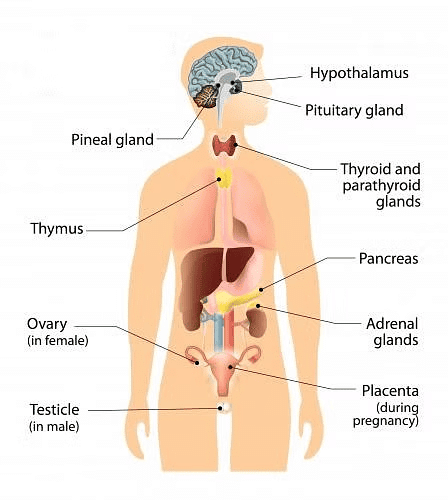
What is Endocrine System?
The endocrine system, in humans, comprises several ductless glands that regulate the body functions or evoke certain responses in the body.
- Chemical Coordination and integration are primarily done by the endocrine glands
- The endocrine system secretes certain hormones directly into the blood that help in regulating different functions of the body. Endocrine System

Facts about Endocrine System
- The branch of biology which deals with the study of the endocrine system and its physiology is known as " Endocrinology".
- Whereas the gland with duct is called exocrine gland which secretes enzyme etc. Endocrine glands pour their secretion directly into the blood. These glands lack ducts, so these glands are called ductless glands.
- Co-ordination in the body of almost all the higher vertebrates is controlled by two systems: Nervous System and the Endocrine system.
- The nervous system and the endocrine system are called the Integrative system of the body.
- The nervous system carries information in the form of impulses to the different parts of the body. High-speed services are offered by this system.
- Whereas the work of coordination by the endocrine system is done slowly by secretion of some chemical substances.
- Substances secreted by these glands are known as hormones. The meaning of the word ' hormone' in Greek is " to excite " = herein.
Question for Endocrine System & Hormonal Reactions
Try yourself:Glands that pour their secretion into the blood are called:
View Solution
Difference between Nervous and Endocrine Coordination
Hormones
Hormones are chemicals that affect a lot of the bodily functions ranging from hunger, reproduction and growth to much more complicated functions like human emotions and behaviour.
- Unlike exocrine glands(sweat, salivary), endocrine glands secrete their respective substances directly into the bloodstream rather than through a duct. These endocrine glands belong to the body’s control system and they produce hormones that help to regulate the functions of cells and tissues.
- Hormones are also called " Primary messengers" or " chemical messengers".
 Hormones from various glands and organs
Hormones from various glands and organs - The first discovered hormone is secretin. It was discovered by Bayliss & Starling in 1902.
- The term hormone was coined by Starling.
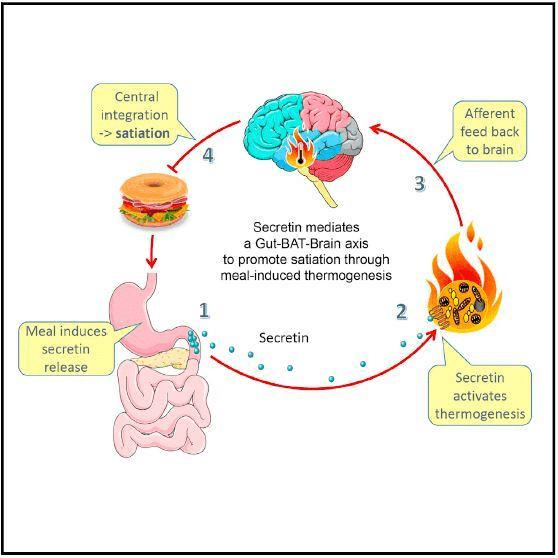 Secretin: First discovered hormone
Secretin: First discovered hormone
Source & Chemical Nature of Hormones
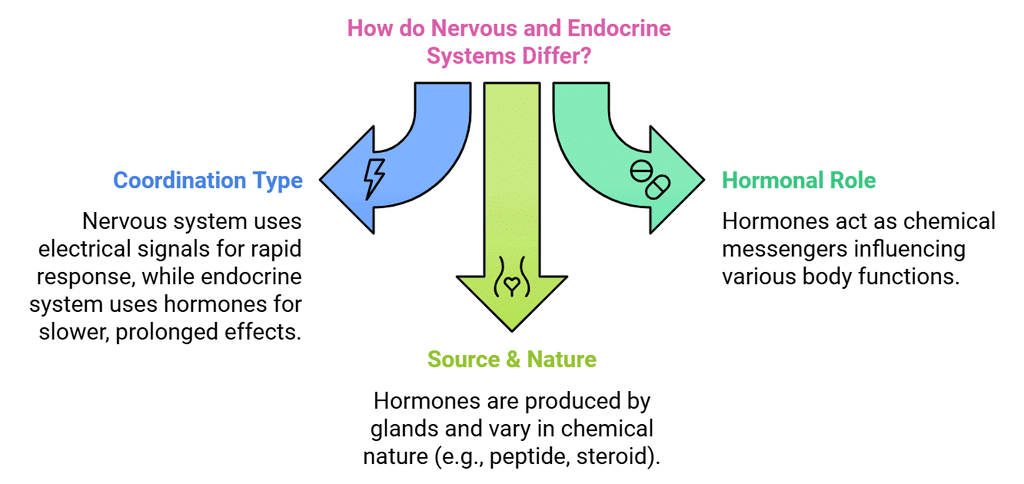
- Hormones are chemical messengers that are secreted by one part of the body and are poured directly into the bloodstream, and they reach their target place with the help of blood.
- A small amount of hormone affects some specific cells or the physiology of cells of organs according to atmospheric conditions.
- These are required in very low concentrations, and some hormones act quickly.
- Hormones are specific and are carried to a specific target organ.
- A few hormones like proinsulin are secreted in an inactive form. These are known as prohormones.
Question for Endocrine System & Hormonal Reactions
Try yourself:Hormones are produced by
View Solution
Differences between Hormones & Enzymes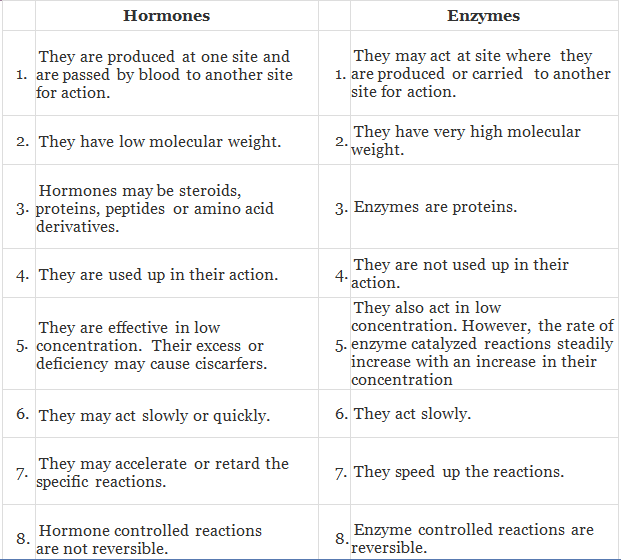
Differences between Hormones & Vitamins
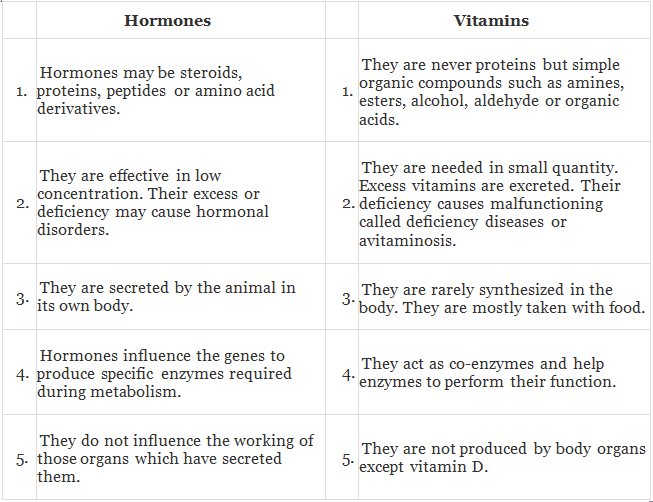
Mechanism of Hormones & Hormonal Reactions
- Once hormone enters into the bloodstream, it can reach almost to any cell in the body.
- However, each hormone affects only certain kind of cells which is called as the target organ.
- All hormone does not act in the same way due to location of receptor.

Two types of Hormones
- Water-soluble hormone
Water-soluble hormones interact with a surface receptor, normally a glycoprotein, and initiate chain events within it. - Lipid soluble hormone
Whereas lipid-soluble hormones (Steroid hormones) readily pass through the plasma membrane to the cytoplasm of the target cell.
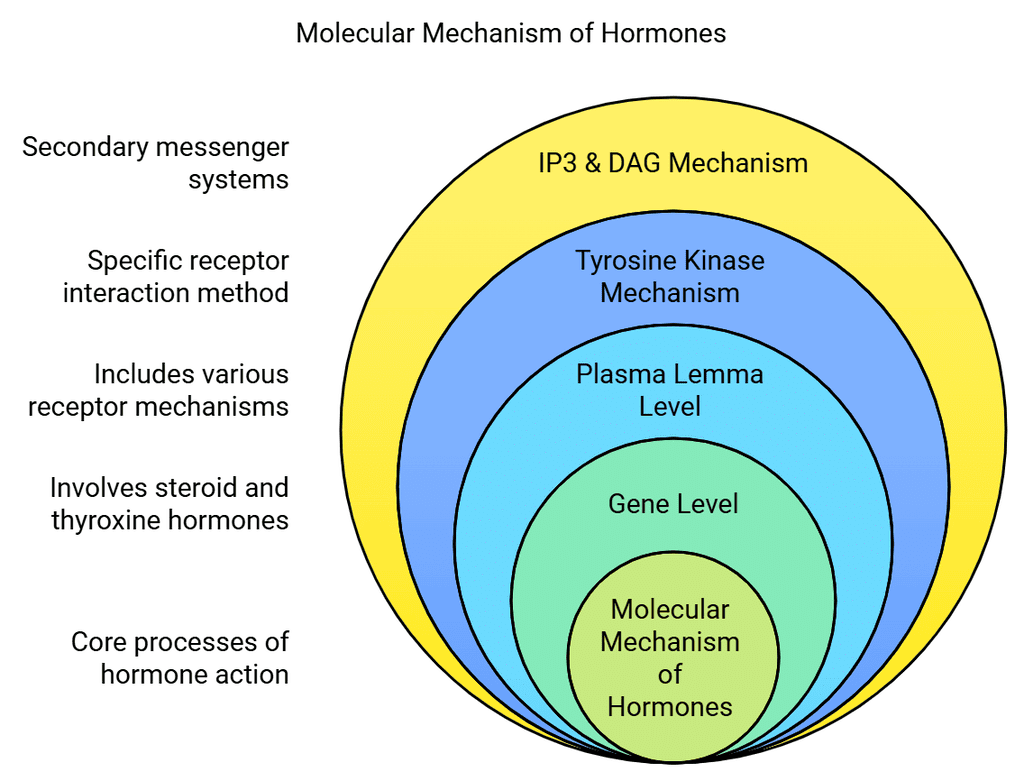
Types of Molecular Mechanism of Hormones
1. Gene Level
In this type of mechanism Steroid hormone and Thyroxine hormones are involved:
a) Steroid Hormones
- In this process, steroid hormones enter into the target cell where they combine with receptor protein, this Receptor protein conveys the hormone from the cytoplasm to the nucleus. This hormone stimulates the DNA for the synthesis of protein. Now DNA synthesizes the m–RNA and this m–RNA goes into the cytoplasm, where Ribosomes synthesize the protein by translation. This new protein is an enzyme, which affects the vital activity of the target cell. Table As Below:
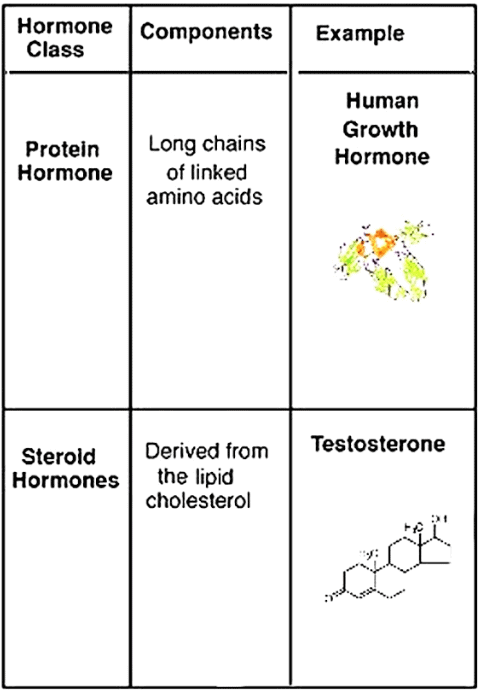
b) Thyroxine Hormone
- The thyroid hormone thyroxine and tri-iodothyronine cause increase transcription by certain gene in nucleus. To accomplish this, These hormones first bind directly with receptor protein in the nucleus. Receptor protein is located on the chromosome.
- Advantage of intranuclear receptor the thyroxin hormone can continue their expression control function for weeks.
2. Plasma Lemma Level
Following hormones are an example of this mechanism:
a) Tyrosine Kinase Mechanism
- A good example of this is the effect of insulin. For transport of insulin hormone, the insulin receptor is found in the cell membrane, which is made up of 4 sub-units. 2 sub-units (a-Protein) are a-protein which are situated towards the outside of the cell membrane.
- This subunit binds the insulin hormone. 2 sub-units (b-Protein) protrude into the cytoplasm of the cell. The intracellular portion of the b units has tyrosine kinase activity. These receptors are usually less than 100 in most of our body cells but maybe more than 1,00,000 as in some liver cells.
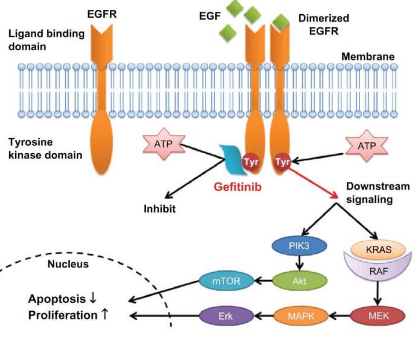 Tyrosine Kinase Mechanism
Tyrosine Kinase Mechanism
b) Binding to the Receptor
- Binding of insulin to the outer 2a subunits of receptor triggers tyrosine kinase activity of the intracellular portion of b-subunits. This causes a structural change in the b-subunit to become an activated tyrosine kinase.
- The activated tyrosine kinase produces autophosphorylation of the cytoplasmic receptor as well as phosphorylation of some cytoplasmic protein.
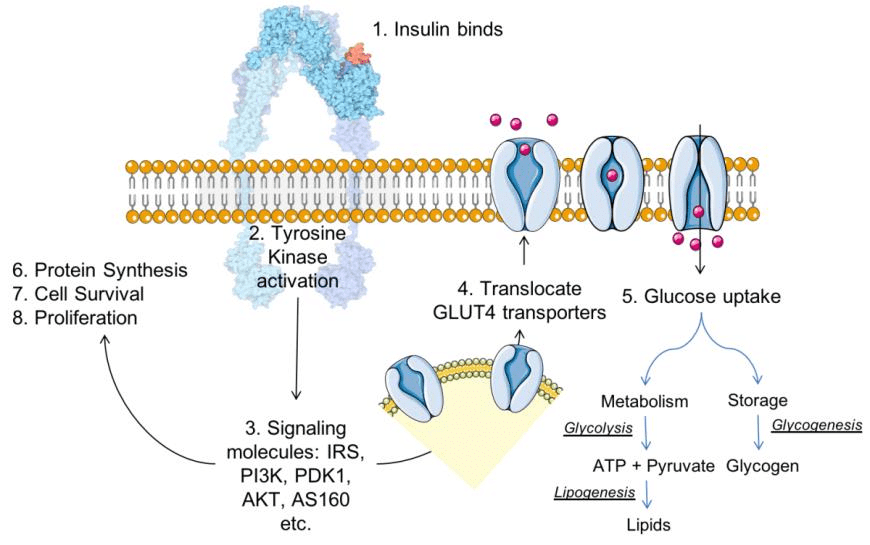 Binding of Insulin
Binding of Insulin
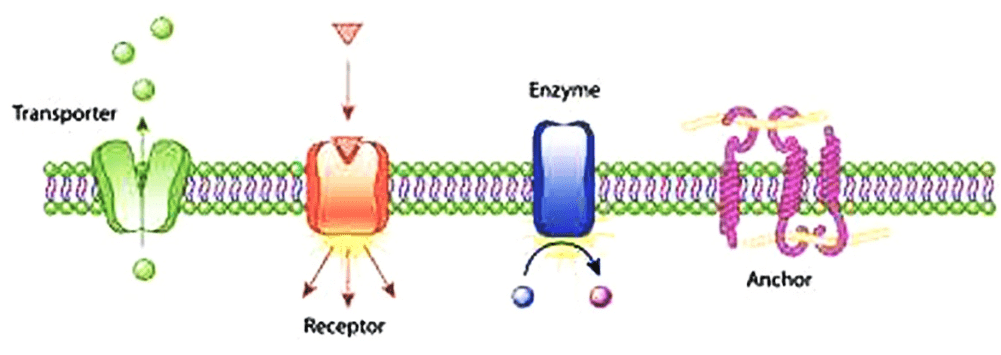 Binding to the Receptor
Binding to the Receptor
c) C-AMP or Second Messenger System
This C-AMP mechanism has been shown by the following hormones:
- Adreno Corticotropin (ACTH)
- Secretin
- Thyroid-stimulating hormone (TSH)
- Catecholamines
- Luteinizing hormone (LH)
- Most hypothalamic releasing hormone
- Follicle-stimulating hormone (FSH)
- Vasopressin/ADH
- Parathyroid hormone (PTH)
- Glucagon: In this type of mechanism when adrenaline is attached to the surface receptor protein found on the plasmalemma then, first of all, it forms a complex which is called as hormone-receptor complex (HRC). A transducer protein is found on the inner surface of the receptor protein, which is called as G-Protein. This G-Protein consists of a, b, g - subunit. GTP is also found on G-Protein.
- After the formation HRC then GTP change into GDP, in this process phosphate group is released which activates the G-Protein.
- After activation of G-Protein, their subunits are divided into two groups:
(i) a -subunit
(ii) b, g - subunit (b, g - subunit both do not separated with each other) - Activated a - subunit of G-Protein activate adenylate cyclase.
- Activated adenylate cyclase change ATP into-C-AMP on cell membrane.
- This C-AMP goes into cytoplasm where it activates the inactive protein kinase-A to active protein kinase-A.
- This active protein kinase A changes inactive phosphorylase kinase into active phosphorylase kinase.
- This active phosphorylase kinase changes inactive Glycogen phosphorylase into active glycogen phosphorylase.
- This active glycogen phosphorylase changes glycogen into Glucose-1-Phosphate.
- Each molecule of protein kinase-A activates about 100 molecules of enzyme phosphorylase kinase and so on.
- As a result, a single molecule of adrenaline releases as many as 100 million molecules of glucose within only 1 minute (Amplification).
d) Amplification
- This means the magnitude of the output of a system is much greater than the input.
- Second messenger CAMP can induce widely differing responses in different cells, depending on what proteins are modified.
e) IP3 & DAG Mechanism
- In this type of mechanism, local hormones are involved such as prostaglandins, Acetylcholine, Somatostatin, etc. THE same CAMP mechanism transduces G-protein act.
- G-protein activates enzyme phosphodiesterase.
- Phosphodiesterase (Phospholipasec) Enzyme breaks phosphatidylinositol bisphosphate into inositol triphosphate (IP3) and diacylglycerol (DAG ).
- IP3 is water-soluble and diffuses into the cytoplasm, IP3 specially mobilized Ca++ ion from smooth endoplasmic reticulum and the Ca++ ion promote smooth muscle contraction, changes in secretion by secretory cell and changes in ciliary action.
- DG remain in the membrane where it activates an enzyme called protein kinase C, which in turn, activates many other enzymes. Activated protein kinase C plays an important role in cell division and cell proliferation.
- The action of lipid-soluble hormone is slower and last longer than the action of the water-soluble hormone.
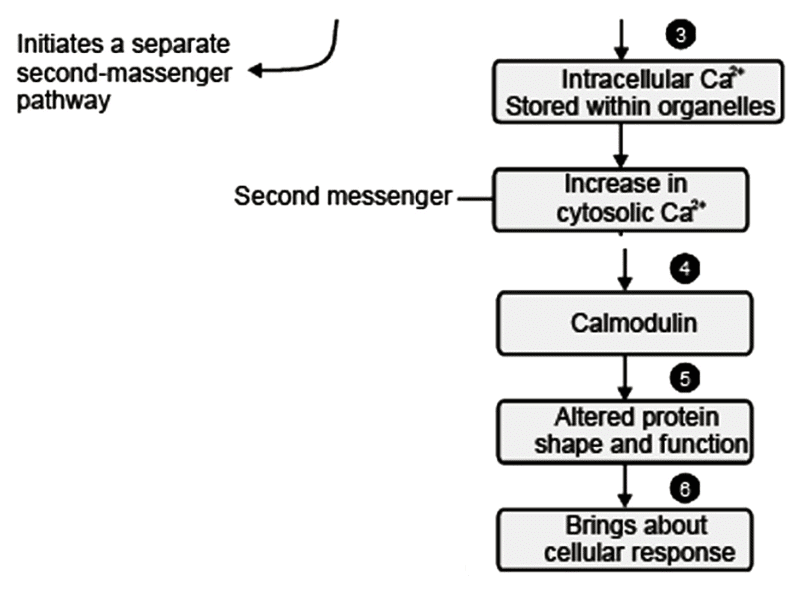 IP3 and DAG Mechanism
IP3 and DAG Mechanism
PIP = Phosphatidylinositol bisphosphate
DAG = Diacylglycerol IP = Inositol trisphosphate
- Binding of an extracellular messenger to a surface membrane receptor activates by means of a G protein intermediary the membrane-bound enzyme phospholipase C.
- Phospholipase C converts PIP2 a membrane component, into DAG and IP3.
- IP3, in turn, mobilizes Ca2+ stored within organelles.
- Ca2+, acting as a second messenger, activates calmodulin.
- Calmodulin induces a change in the shape and function of a particular intracellular protein. Many of the Ca++ dependent cellular events are triggered by the activation of calmodulin.
- The altered protein then produces the desired cellular response dictated by the extracellular messenger.
Old NCERT Syllabus
 |
Download the notes
Endocrine System & Hormonal Reactions
|
Download as PDF |
Download as PDF
Important Terms (Hormones)
- Chalones → The hormones which are secreted from one endocrine gland to stimulate other endocrine gland is called Chalones.
- Autocoide → The hormone which is secreted from one endocrine gland to target organ is called as Autocoide.
- Diabetogenic → The hormone which mainly affects or stimulates carbohydrate metabolism, is called as Diabetogenic.
- Ketogenic→ The hormone, which mainly affects fat metabolism.
- Calorigenic→ The hormone, which mainly affects the basal metabolic rate (BMR) is called as calorigenic.
Six Types of Animal Hormones
1) Amino Acid Derivatives
- The hormones epinephrine and norepinephrine from the adrenal medulla and thyroxine from the thyroid gland are derived from an amino acid.
2) Short Peptides
- The hormones oxytocin and vasopressin from the posterior lobe of the pituitary gland are short peptides of 9 amino acids. The melanocyte-stimulating hormone (MSH) from the intermediate lobe of the pituitary gland is also a short peptide of 13 amino acids.
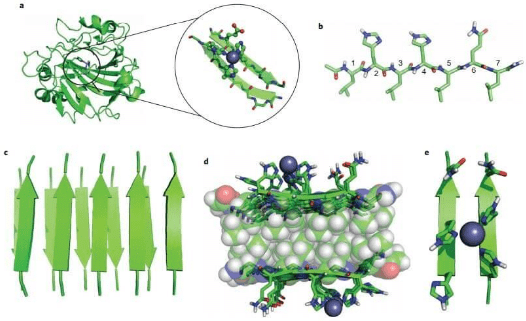 Short Peptides
Short Peptides
3) Long Peptides
- The hormones insulin from the pancreas, adrenocorticotropin (ACTH) from the anterior lobe of the pituitary gland, calcitonin from the thyroid gland are longer peptides of above 30 amino acids, parathormone from the parathyroid gland consists of 84 amino acids.
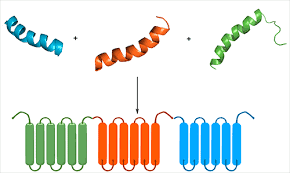 Long Peptides
Long Peptides
4) Protein
- The gonadotropic, thyrotropic, and somatotropic hormones from the pituitary's anterior lobe are proteins with high molecular weights.
 Protein
Protein
5) Steroids (Fat-soluble)
- The hormones like cortisol and aldosterone from the adrenal cortex, testosterone from interstitial cells of testes, estrogen, and progesterone from Graafian follicles of the ovary and placenta are examples of steroid hormones.
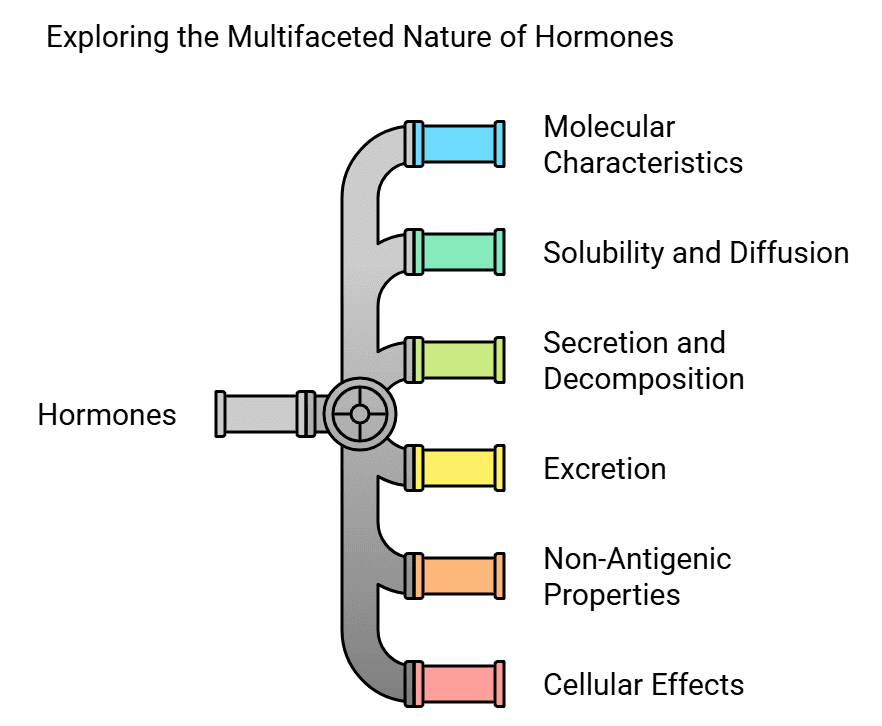
6) Fatty Acid Derivative
- The molecules of most of the hormones are small, and their molecular weight is low.
- Hormones are soluble in water and are easily diffusible in tissues.
- The secretion of hormones is always in a very small quantity because these are the most reactive substances.
- Hormones are destroyed after use i.e. hormones can not be stored in the body. Thyroxine is an exception in this regards.
- The liver and kidneys separate hormones from blood and decompose them. The product formed after decomposition is excreted with urine. It can not be reutilized.
- Hormones are non-antigenic & non-species specific substances.
- Usually, hormones do not participate in the metabolic activities of target cells but they affect and control the activity level of these target cells. Due to the effect of hormones, not only the rate of metabolic activities is affected but also the permeability of the cell membrane is changed so the nature of reactions is also changed.
The document Endocrine System & Hormonal Reactions | Science & Technology for UPSC CSE is a part of the UPSC Course Science & Technology for UPSC CSE.
All you need of UPSC at this link: UPSC
|
114 videos|430 docs|209 tests
|
FAQs on Endocrine System & Hormonal Reactions - Science & Technology for UPSC CSE
| 1. What is the endocrine system and what are its primary functions? |  |
| 2. What are hormones and how do they affect the body? |  |
Ans. Hormones are chemical messengers produced by endocrine glands that travel through the bloodstream to target organs or tissues, affecting various physiological processes. They play a crucial role in regulating metabolism, immune response, mood, and other vital functions.
| 3. How do hormones differ from enzymes? |  |
Ans. Hormones are chemical messengers that travel through the bloodstream to target cells and regulate physiological processes, while enzymes are biological catalysts that speed up chemical reactions in the body. Hormones have a broader regulatory function, whereas enzymes primarily assist in metabolic processes.
| 4. What is the difference between hormones and vitamins? |  |
Ans. Hormones are produced by endocrine glands and function as chemical messengers to regulate bodily functions, while vitamins are organic compounds that are essential nutrients needed for various biochemical reactions in the body but are not produced by the body in sufficient amounts. Vitamins support overall health, while hormones specifically regulate processes.
| 5. What are the mechanisms through which hormones act on target cells? |  |
Ans. Hormones act on target cells through two main mechanisms: the first involves lipophilic hormones (like steroid hormones) that pass through cell membranes and bind to intracellular receptors, influencing gene expression. The second involves hydrophilic hormones (like peptide hormones) that bind to receptors on the cell membrane, triggering signaling pathways that lead to a physiological response.
Related Searches



















